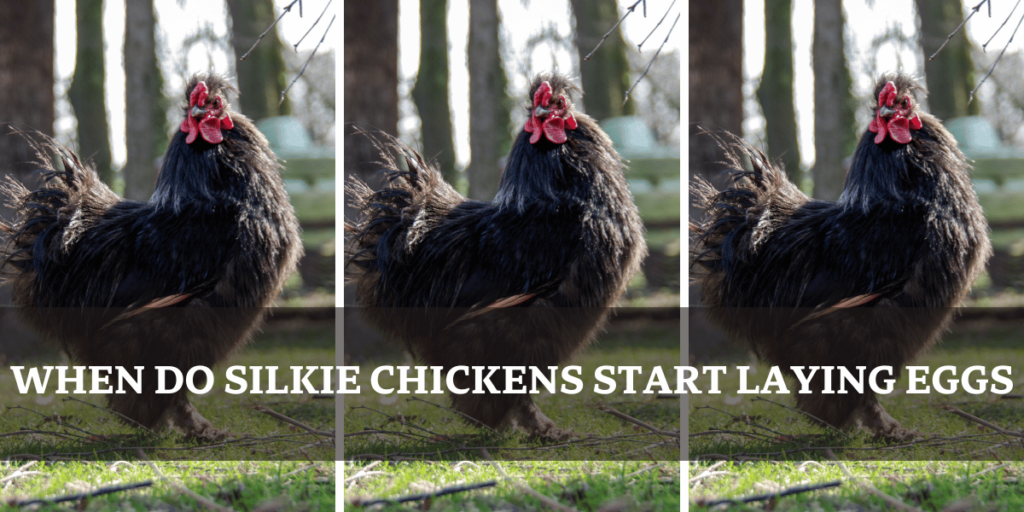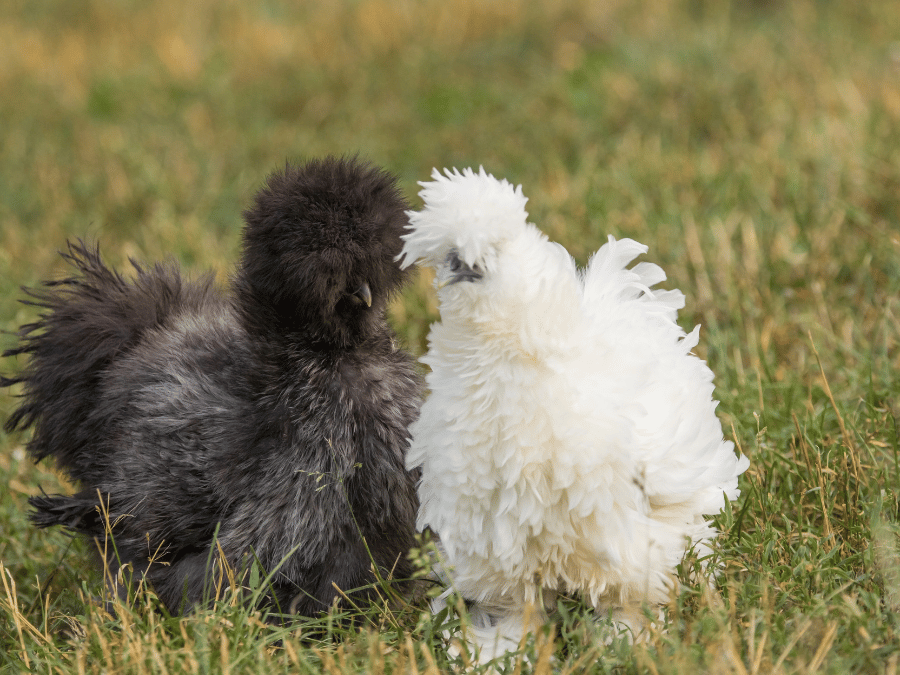
When do silkie chickens start laying eggs? If you’re curious about these adorable birds, you’re in the right place!
Silkie chickens are celebrated for their fluffy feathers, friendly personalities, and unique appearance, making them a favorite among backyard farmers and homesteaders alike. Not only do they bring charm to any flock, but they are also known for their impressive egg-laying capabilities.
In this guide, we’ll dive into the specifics of Silkie chickens, including their characteristics, care requirements, and the exciting moment when they begin laying eggs, ensuring you have all the information you need to enjoy these delightful birds.
This Post Is All About When Do Silkie Chickens Start Laying Eggs?
Silkie Chickens and Their Unique Characteristics
Silkie chickens are beloved for their special traits and charm among backyard chicken enthusiasts. Originating from ancient China, these birds have a fascinating history tracing back to the Han Dynasty.
Notably, Marco Polo documented encountering “furry chickens” with distinctive black skin and bones during his journeys.
Today, these silkies are adored for their fluffy plumage, reminiscent of fur rather than traditional feathers.
What Makes Silkies Stand Out?
Fluffy Feathers: Silkie chickens boast fur-like feathers that contribute to their adorable and distinctive appearance.

Black Skin and Bones: Contrary to typical chickens, silkies exhibit black skin, bones, and even meat.
Extra Toe: Silkies are unique with five toes on each foot, setting them apart from other chicken breeds.
Variety of Colors: Silkies showcase a range of captivating hues, including white, black, blue, and buff.
Gentle Temperament: Renowned for their tranquil and amiable nature, silkies make wonderful companions.
Exploring Different Silkies
Silkie chickens present various types and sizes, each with its own set of special characteristics. Understanding these distinctions can aid in selecting the ideal silkie breed for your backyard flock.
Bantam Silkies vs. Standard-Sized Silkies
Bantam Silkies: These smaller versions are favoured for compact spaces or as show birds.
Standard-Sized Silkies: Larger and sturdier, suitable for egg production and meat.
Color Varieties of Silkies
Silkies are available in a kaleidoscope of colors, each contributing to the allure of your flock. Popular colour variations include:
White Silkies: Featuring pristine, pure white feathers for an elegant look.
Black Silkies: Exuding a dark, mysterious, and striking beauty.
Blue Silkies: Showcasing soft blue feathers for a serene aesthetic.
Buff Silkies: Sporting warm, golden-brown feathers that are simply delightful.
Enhancing Your Knowledge
For those eager to delve deeper into the world of silkies, exploring the American Standard of Perfection and breed standards can provide valuable insights.
Additionally, learning about famous figures like Ulisse Aldrovandi and the history of Chinese silk chickens can enrich your understanding.
Understanding the Silkie Hen’s Egg-Laying Cycle
Silkie hens are known for their broodiness, which can affect their egg-laying patterns. However, with proper care and attention, you can enjoy a steady supply of silkie eggs.
When Do Silkie Chickens Start Laying Eggs?
Silkie hens typically start laying eggs at around 5 to 8 months of age. However, this can vary based on factors such as diet, environment, and overall health.
It’s essential to provide them with a balanced diet and comfortable living conditions to encourage timely egg production.
Egg Production Patterns
Silkie hens are not prolific layers compared to other chicken breeds like Rhode Island Reds. On average, a silkie hen can lay about 100 to 120 small white eggs per year.
While they may not be the highest in egg production, their eggs are delicious and perfect for small families.
Factors Affecting Silkie Chicken Egg Production
Several factors can influence the egg production of silkie hens. Understanding these factors can help you optimize their laying potential.
Diet and Nutrition
- Balanced Diet: Ensure your silkies receive a balanced diet with layer feed rich in protein and calcium.
- Fresh Fruits and Vegetables: Supplement their diet with fresh fruits and vegetables to provide essential vitamins and minerals.
- Oyster Shells: Provide oyster shells as a calcium supplement to strengthen eggshells.
RELATED POST: Best Guide On How To Prevent Egg Bound Chickens
Environment and Housing
- Comfortable Coop: Ensure your chicken coop is clean, dry, and well-ventilated to keep your silkies healthy.
- Free Range: Allow your silkies to free range during the day to forage for insects and greens, promoting natural behavior.
- Nest Boxes: Provide cozy nest boxes with soft bedding to encourage laying.
Health and Well-being
- Regular Health Checks: Monitor your silkies for signs of health issues and provide timely treatment if needed.
- Fresh Water: Ensure a constant supply of fresh water to keep your silkies hydrated.
- Human Interaction: Spend time with your silkies to build trust and reduce stress levels.
Signs to Look for When Silkie Chickens are Ready to Lay
Knowing when your silkie hens are ready to lay can help you prepare and provide the necessary care.
Physical Signs
- Reddening Comb and Wattles: A clear sign that your silkie hen is reaching maturity and ready to lay.
- Squatting Behavior: Hens may squat when you approach, indicating they are preparing to lay eggs.
- Increased Activity Around the Nest Box: Hens may start spending more time in the nest box, arranging bedding.
Behavioral Changes
- Nesting Instinct: Hens may show increased interest in nest boxes, scratching and arranging bedding.
- Cackling: Hens may become more vocal, especially after laying an egg.
Tips for Encouraging Silkie Chickens to Lay Eggs
Encouraging your silkie hens to lay eggs involves providing the right environment, diet, and care.
Proper Diet and Nutrition
- Layer Feed: Ensure your silkies receive high-quality layer feed with essential nutrients.
- Fresh Greens: Offer fresh greens like spinach and kale to boost their nutrient intake.
- Treats in Moderation: Provide treats like mealworms and sunflower seeds occasionally to keep them happy.
Nesting and Housing
- Comfortable Nest Boxes: Provide soft bedding in nest boxes to make them inviting.
- Calm Environment: Minimize stressors like loud noises and predators to create a peaceful laying environment.
- Consistent Lighting: Ensure consistent daylight hours to maintain their laying cycle.
Managing Silkie Chicken’s First Eggs and Egg Production
Managing the first eggs your silkie hens lay is crucial for their long-term egg production.
Collecting and Storing Eggs
- Regular Collection: Collect eggs daily to prevent them from becoming dirty or damaged.
- Proper Storage: Store eggs in a cool, dry place to maintain freshness and quality.
Monitoring Health and Productivity
- Health Checks: Regularly check your silkie hens for signs of illness or distress.
- Productivity Records: Keep track of egg production to identify any changes or issues early.
Health Concerns to Watch Out For
Silkie chickens, like any other breed, can face health issues that may affect their egg production.
Common Health Issues
- Marek’s Disease: A viral disease that can affect young silkies; vaccination is recommended.
- Egg Binding: When an egg gets stuck in the hen’s oviduct, requiring immediate attention.
- External Parasites: Regularly check for mites and lice and treat promptly.
Preventive Measures
- Clean Coop: Maintain a clean and dry coop to prevent the spread of diseases.
- Regular Deworming: Deworm your silkies periodically to keep them healthy.
- Healthy Diet: Provide a balanced diet to boost their immune system.
Frequently Asked Questions
How Many Eggs Do Silkie Chickens Lay?
Silkie hens are known for their unique appearance and gentle demeanor, producing around 100 to 120 small white eggs each year. While this might seem modest compared to more prolific breeds of chickens like the Rhode Island Red or Easter Eggers, silkies are celebrated for the quality of their eggs rather than quantity.
These small eggs are not just tasty; they make for a delightful treat for any proud owner of silkies. Conversely, for those interested in meat production, it’s worth noting that silkies are considered poor layers compared to other breeds. However, their charm and temperament certainly make them excellent choices as pets!
What Age Do Silkie Chickens Start Laying Eggs?
Silkie hens typically begin their egg-laying journey when they reach about 5 to 8 months of age. This milestone is often an exciting time for anyone raising these beautiful birds, as they transition into adulthood and start contributing to the flock.
The anticipation of that first egg can be thrilling for both new and experienced chicken keepers! It’s a perfect opportunity to engage with the local breeder, or even check out forums and community threads for tips on caring for your silkie chickens.
Are Silkie Chickens Good Layers?
While silkie hens may not rank high among prolific egg layers, and some might label them as poor layers compared to breeds like the Rhode Island Red, they maintain a consistent output of small eggs.
For those who appreciate their unique appearance and gentle nature, silkies are an excellent choice. Interestingly, they are also known to be excellent mothers, nurturing their silkie chicks with utmost care.
Whether you’re a proud owner of silkies or contemplating adding a few of these charming birds to your flock, their endearing qualities and ability to thrive in various conditions, including extreme temperatures, make them a top choice.
Where Do Silkie Chickens Originate From?
Silkie chickens, often referred to as Chinese silk chickens, have a long history that traces back to Southeast Asia and the Silk Road. Their fluffy feathers and unique traits, including black bones found in some varieties like the black silkie hen, set them apart from other pure breeds.
If you’re considering starting your own flock or adding to your first silkies, remember to seek out reputable breeders who can provide guidance on proper chicken feed and care.
How Do I Increase Egg Production in Silkie Hens?
To boost egg production in your silkie hens, focus on a few key factors:
- Balanced Chicken Feed: Providing high-quality, balanced chicken feed ensures that your hens get the nutrients they need. Look for feed that meets the American Poultry Association standards.
- Comfortable Nesting Conditions: Create a cozy and stress-free environment. Comfortable nesting boxes will encourage your hens to lay their clutch of eggs without interruptions.
- Pecking Order Management: Be aware of the pecking order within your flock. Small chickens like silkies can sometimes be bullied by more dominant breeds, so keeping a harmonious environment is crucial.
- Stress-Free Environment: Minimize stressors, such as extreme temperatures or disruptions, to help your hens maintain their laying routine.
Fun Facts About Silkie Chickens
- Silkie chickens are often referred to as “furry chickens” due to their unique feather texture, which is reminiscent of fur rather than traditional feathers.
- They have striking feather colors, including black, white, and blue, and fascinating traits like black bones and skin, making them stand out in any chicken coop.
- Being an old breed, they trace their origins back to Southeast Asia and were known as “Chinese silk chickens.”
- Their calm and gentle temperament makes them a top choice for families and those looking to keep chickens in urban settings.
The Joy of Raising Silkie Chickens
Raising silkie chickens is a rewarding experience that brings joy and a sense of accomplishment.
From their fluffy feathers to their gentle temperament, silkies make great pets and valuable additions to any backyard flock. By understanding their unique needs and providing proper care, you can enjoy a steady supply of delicious silkie eggs, while building a deeper connection with these charming birds.
Ready to start your silkie chicken adventure? Follow our community of backyard farmers and homesteaders, and let’s explore the world of silkie chickens together. Share your experiences, ask questions, and celebrate the joys of raising these wonderful birds.
Happy homesteading!
